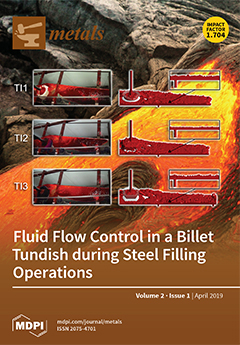Microstructure and corrosion behavior of the Mg-3Al-
xMn (
x = 0, 0.12, 0.21, 0.36, 0.45) (hereafter in wt.%) alloys were experimentally investigated by electron probe microanalysis (EPMA), scanning electron microscope equipped with energy dispersive X-ray spectroscopy (SEM/EDX), X-ray diffraction (XRD), electrochemical,
[...] Read more.
Microstructure and corrosion behavior of the Mg-3Al-
xMn (
x = 0, 0.12, 0.21, 0.36, 0.45) (hereafter in wt.%) alloys were experimentally investigated by electron probe microanalysis (EPMA), scanning electron microscope equipped with energy dispersive X-ray spectroscopy (SEM/EDX), X-ray diffraction (XRD), electrochemical, and hydrogen evolution tests. A new self-constructed Mg-Al-Mn-Fe thermodynamic database was used to predict the solidification paths of the alloys. The addition of Mn showed no grain refinement in the cast Mg-3Al alloys. According to the microstructure observation, Al-Fe phases were observed in the non-Mn-added alloy, while Al
8Mn
5(LT) (Al
8Mn
5 in low temperature) became the main intermetallic phase in the Mn-added alloys, and the amount increased gradually with the Mn addition. The τ–Al
0.89Mn
1.11 phase with lower Al/(Fe + Mn) ratio was observed in the alloys with 0.36 and 0.45 wt.% Mn content. According to the electrochemical tests, all five alloys showed localized corrosion characteristics in 3.5 wt.% NaCl solution. Compared with the Mg-3Al alloy, the corrosion resistance of Mn-added alloys were significantly improved and increased gradually with the Mn addition, which was due to the variation of Al-containing intermetallic compounds. The present experimental investigations and thermodynamic calculations confirmed the mechanism that the increasing amount of Al
8Mn
5(LT) with Mn addition could encapsulate the B2-Al(Mn,Fe) phase with higher Fe. Therefore, it could prevent this detrimental phase from contacting magnesium matrix, thus suppressing micro-galvanic corrosion and improving corrosion resistance gradually.
Full article





